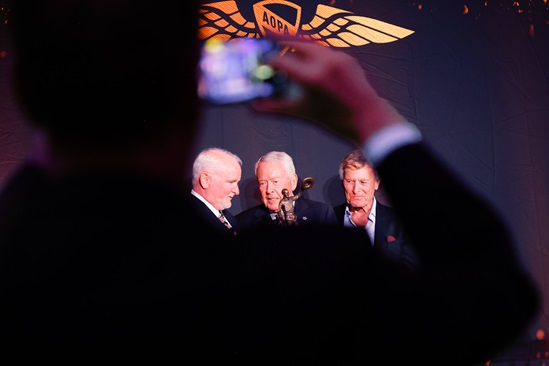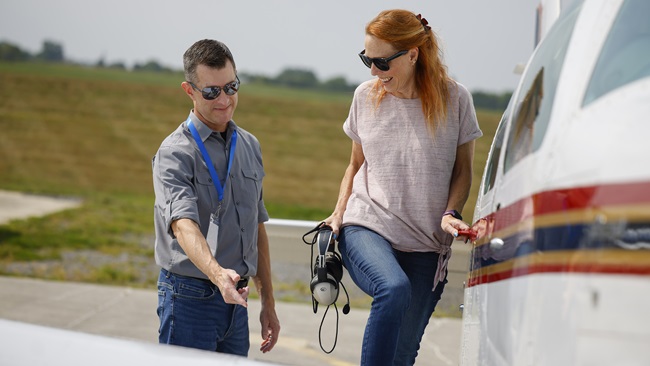Think quickly, remain calm
Controllers honored by NATCA, AOPA
Electrical failures, an in-flight fire, icing, and missing flights with people in need of rescue were among the nightmare scenarios that saw air traffic controllers step up and offer steady guidance to safe outcomes. Each year, certain "saves" stand out from the rest, and peers and pilots pay tribute to ATC personnel whose actions saved lives.
On Super Bowl Sunday 2017 pilot Peter Edenhoffer was approaching home in his 1977 Cessna Cardinal when the lights went out. The story that unfolded from there could have had a very different outcome had air traffic controllers not stepped up, improvised, and helped the pilot solve the problem.
Air traffic controllers in Fort Worth Center knew, and controllers Phil Enis, Thomas Herd, and Hugh Hunton guided Edenhoffer to safety. The only communication Edenhoffer could manage was a text on his cellphone to his family. Surprisingly that text led to this: “This is Fort Worth Center. Respond if possible. Weather improves west.”
Controllers possess some unique qualities, such as the ability to think quickly and remain calm under pressure while maintaining situational awareness. Their willingness to resolve complex situations without hesitation and offer a reassuring voice to those on the frequency, and the ability to coordinate their efforts with other controllers, and in some cases other airmen, help ATC maintain the safety of the National Airspace System.
Controllers often say that they are “just doing their job,” but their work is viewed by others as remarkable and extraordinary. The Archie League Medal of Safety Awards were named for the first air traffic controller, Archie League. The program highlights a variety of aviation “saves”—some involve a team of controllers working together, while others are the result of one controller’s efforts.
The National Air Traffic Controllers Association honored controllers whose efforts made a difference during its Communicating for Safety conference in Las Vegas in October, when the Archie League Medal of Safety Awards selection panel announced the fourteenth annual Archie League recipients:
Alaskan Region
Scott T. Eastepp (Anchorage Center, ZAN)
Family members reported an overdue aircraft prompting a frantic search for the VFR flight with a storm bearing down. Eastepp, reviewing recorded radar data, spotted a primary target (the missing Cessna 180 had no transponder), and was able to contact another flight that had spotted the missing aircraft, significantly narrowing the search area. ATC personnel pieced together radar tracks that led them to the missing flight, which had flipped after an attempted landing, and initiated a lifesaving U.S. Coast Guard rescue. This NATCA video tells the story.
Central Region
Josh Giles (Kansas City Center, ZKC)
Giles had just begun the midnight shift when Denver Center called to advise that a flight was about to enter his sector with an electrical problem. "OK, we'll figure it out," Giles told Denver. Things were about to get a lot worse. Find out what happened next in this NATCA video.
Eastern Region
Jeffrey Haberland and Tim Krainak (Clarksburg ATCT, CKB)
A Grumman American AA–5 was in trouble, and trying to route around bad weather. With ice forming on the wings and windshield, controllers Haberland and Krainak worked as a team to guide the pilot safely over terrain and under the icy clouds to a safe landing, a story detailed in this NATCA video.
Great Lakes Region
Daniel Rak (Indianapolis Center, ZID)
Rak was handling airspace above the Charleston, West Virginia, approach control sector when a pilot called from 8,000 feet with an urgent request for help getting out of icing. Rak was able to help the ice-laden aircraft manage a safe landing, a story detailed in this NATCA video.
New England Region
Jesse Belleau (Boston TRACON, A90)
Belleau heard the chilling words, "We need immediate landing with smoke in the cockpit. Fire confirmed," and quickly came up with options. Then he offered other options. Watch what happened in this NATCA video.
Northwest Mountain Region
Christopher Bancroft and Jacques Mailloux (Broomfield Jefferson County ATCT, BJC); Jeffrey Rawson (Salt Lake City ATCT, SLC)
A Mooney called ground control for taxi clearance, but something was obviously not right. It took teamwork to avoid disaster, as this NATCA video shows. (Thankfully, it is rare that controllers must save a pilot from himself.)
Southern Region
Joshua Hall, Patrick Allen Johnson, Jeremiah Lee, Darren P. Tumelson, William T. Vaughn III, and Andrew John White (Memphis Center, ZME)
Over the course of a two-hour aerial ordeal that included locked flight controls, autopilot problems, loss of pitch control, and a hydraulic failure, this team of Memphis controllers came through, a story detailed in this NATCA video. (Note: This video contains strong language.)
Southwest Region
Phil Enis, Thomas Herd, and Hugh Hunton (Fort Worth Center, ZFW)
As noted above, Texas physician and pilot Peter Edenhoffer was in a very tough spot that required some improvisation by air traffic control to guide him to a safe landing. Read the story from Edenhoffer's point of view here, and watch the NATCA video to see how it played out from the controller's perspective.
Western Pacific Region
Benjamin Kingston (San Francisco ATCT, SFO) and Scott Allen (Tucson ATCT, TUS)
Two saves from the region earned Archie League Medal of Safety awards for controllers, both of whom helped prevent collisions. San Francisco controller Benjamin Kingston relied on a combination of his experience and his gut to anticipate and prevent a disastrous runway incursion. Scott Allen was honored for a lightning-quick reaction to another close call in Tucson, Arizona.
The AOPA Air Safety Institute joined NATCA in honoring controllers. Paul Deres, the Air Safety Institute’s director of education, presented the AOPA Air Safety Institute Flight Assist Commendation Awards, noting the pilot community’s appreciation for air traffic controllers’ professionalism and commitment to safety.
“In many cases it’s the controllers who make a difference between us getting to our destinations safely and not getting there at all,” he said. “As an expression of our gratitude, 10 years ago we created the AOPA Air Safety Institute Flight Assist Commendation Award, which uniquely recognizes controllers for their exceptional service, situational awareness, and teamwork in helping GA pilots in dire circumstances land safely.”
The award recipients honored by the Air Safety Institute were:
- Brian Roth of the Chicago Terminal Radar Approach Control facility for providing exemplary service and coordination to the distressed pilot of a PA–14 Family Cruiser who encountered adverse weather and required assistance finding a place to land the evening of May 1, 2017.
- Jimmy Pepper of the Terre Haute Regional Airport air traffic control tower in Indiana, for providing exemplary service and coordination to a Cessna 150 pilot who experienced multiple equipment failures while practicing instrument approaches in instrument meteorological conditions on March 28, 2018.
- Joshua McPhee of Spokane International Airport in Washington, whose exemplary service and coordination efforts on April 8, 2018, assisted a Cessna 210 pilot who had experienced significant loss of engine power, partial vacuum failure, and intermittent radio problems.
- Tower controller Victor Sahijram of Charleston International Airport in South Carolina, whose exemplary service on Jan. 12, 2018, provided assistance to a Beechcraft Bonanza pilot who was experiencing intermittent radios caused by an electrical failure.
- Tim Martin, Ruben Lopez, Karen Hagstrom, and Chris Walton, tower controllers at Daytona Beach International Airport in Florida, for exemplary teamwork and service on April 26, 2018, to a Cessna 172 pilot whose aircraft windscreen and side windows became covered with oil, permitting no outside visibility.
- Central Florida Tracon controllers Dan McNeil, Eric Abernethy, and Vijay Kanhai for exemplary service, problem solving, and coordination efforts when assisting the crew and passengers of a Cessna Citation III that experienced main landing gear failure on March 30, 2018.
- Evan Munro of the Miami Air Route Traffic Control Center for exemplary service credited with saving the passenger’s life on Dec. 14, 2017, when a Cessna 210 experienced engine problems, resulting in ditching. The pilot did not survive.
- Chris Williams of the Nashville, Tennessee, tracon for exemplary service to the pilot of a Cessna 182 who nearly experienced loss of control after encountering adverse weather on Dec. 21, 2017.
For years the Air Safety Institute has worked with NATCA to develop safety education for thousands of GA pilots and controllers through safety videos, online courses, and seminars at AOPA events, “and we are grateful for your involvement,” Deres said.
The You Can Fly program and the Air Safety Institute are entirely funded by charitable donations to the AOPA Foundation, a 501(c)(3) organization. To be a part of the solution, visit www.aopafoundation.org/donate.



